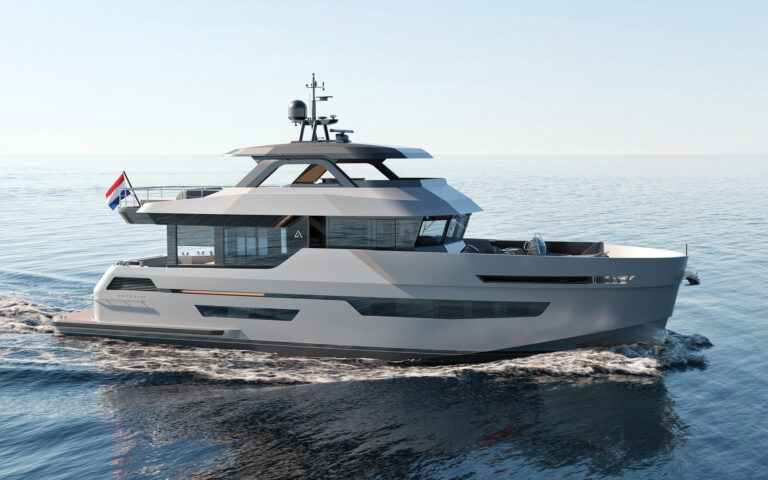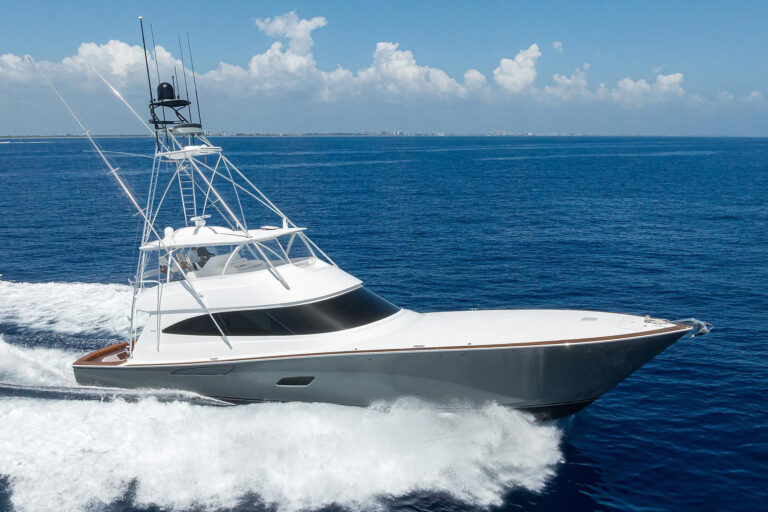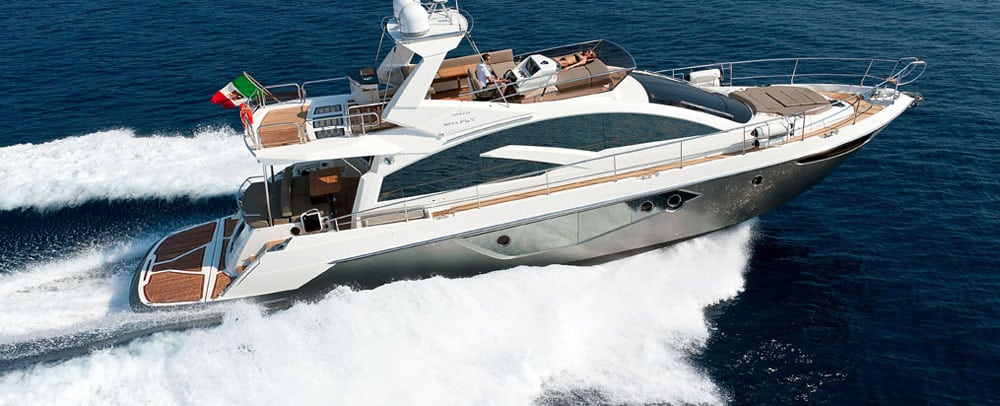
Cranchi 66 Main
The year is 1865. The civil war ends, Lincoln is assassinated, the Matterhorn is ascended for the first time, and the 13th Amendment to the Constitution is ratified, ending slavery in the United States. It’s hard to believe, but Giovanni Cranchi is already hard at work on the shores of Italy’s Lake Como, building high-quality fishing and cargo boats.
It is, in these economic times, somehow refreshing to find a boatbuilder whose history is measured not in years, but in generations. The success of Cantiere Nautico Cranchi stands as a testament to nearly 150 years of Cranchi family members who have faithfully carried on the standards set in those early days.
Take a walk through the new Sixty 6 Fly (really, that’s how they spell it) and you’ll see that quality is a tradition that hasn’t wavered in five generations. Yes, this is a thoroughly modern European yacht with all that suggests: swoopy lines, acres of sun pads, coolly stylish interior. Yes, it’s got a huge list of standard equipment that includes everything from a complete spare parts kit to a corkscrew in a fitted drawer (Viva Italia!) to a forward-looking infrared FLIR camera for night running. But it’s when you get to the details that you realize what really separates a Cranchi from all the rest.
Take the fuel and water fillers on the side decks, for example. Cranchi could have bought an off-the-shelf, chrome-plated filler, but that wasn’t good enough: A welded filler might weep with age, while a cast filler might develop cracks. So a machinist somewhere in the depths of the four Cranchi yards took a billet of solid stainless steel and then meticulously machined it into a jewel-like piece of hardware that you would never even notice unless you looked. But it will also never fail.
Wrap your hand around the oversize welded stainless-steel rails, and you can feel that they are not just solid but really solid. Looking into lockers has always been a way to judge quality: Some lockers are roughly finished, and others (like those on the Cranchi) are finished to the same level as the living areas. But scrunch around until you can see the top of the Cranchi locker. In several lockers are tiny hatches, which allow you to reach the stanchion bases without ripping apart the luscious interior.
I also found so much redundancy on the Sixty 6 Fly that I started to wonder if the company was getting two-for-one deals on systems, but, no, that’s just how it builds its boats: extra water pumps so you can always take a hot shower, extra air conditioning so the cabins are cool, multiple bilge pumps in the same spaces so there is never a question of failure.
This particular Sixty 6 Fly (forgive me, but I’ll call it the 66 from here on) was ordered by an American yachtsman already on his second Cranchi, and he made some thoughtful changes to the layout, which underline the builder’s flexibility.
At first glance, this is your typical Riviera rocket, with its steeply raked windscreen, free-form windows and melted lines. There are, by actual count, no fewer than four sunning areas on the deck and bridge.
Step aboard the extra-wide hydraulic swim platform that, in this case, launches a 12-foot Nautica RIB with a 40-horse outboard at the touch of a button. Easy teak stairs lead to the first entertainment area: the afterdeck with wraparound dinette, a fiberglass wet bar and, of course, a sun pad.
I know the Italians engineered aqueducts and highways when most of the world was living in mud huts, but, for a true engineering miracle, you have to examine the doors between afterdeck and salon. All three panels slide down smoothly to become “Dutch doors,” opening the salon to fresh air and easy conversation with the cockpit. Bellissima!
The standard interior has a comfortable settee with table to port, opposite a counter that hides a pop-up TV and doubles as a buffet, while a second seating area is forward near the helm. The owner of this 66 switched those two areas, moving the buffet forward and creating a pleasant seating area aft in the salon with facing lounges. Even better, part of the seating can be moved closer to the fold-out dining table, allowing four couples to enjoy a meal without crowding.
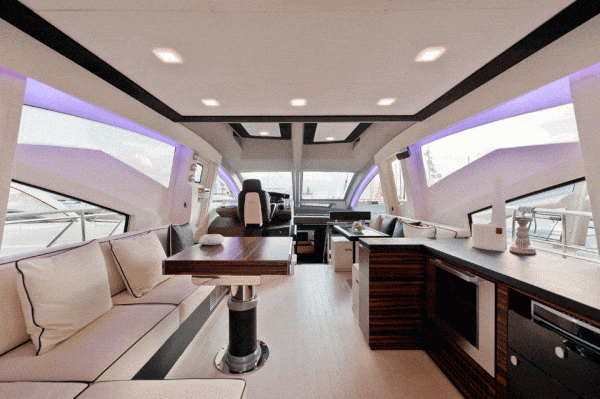
Dining, in fact, is one of the features the owner mentioned when I asked him what he enjoyed about his 66: “We spend a lot of time in the Bahamas, and we have four separate dining areas aboard, depending on our needs.” In addition to those on the afterdeck and salon, there is another table on the bridge and one on the foredeck sun pad that converts into a U-shape settee with large table. It would be delightful to dine there, enjoying dusk in a quiet anchorage.
Décor for the salon is a pleasantly warm blend of ribbon-grain teak and stitched leather in cream and chocolate, and the large windows provide, for the most part, a good view. There is a huge styling accent on the exterior that inexplicably slices one large window into two smaller peepholes, an unfortunate victory of design aesthetics over function.
The skipper gets a quite luxurious helm in the forward port corner of the salon, with a fully adjustable helm seat that could be straight from Star Trek and a multilevel dash cascading around the steering wheel clearly purloined from an exotic Italian sports car. Straight ahead is a Raymarine 14-inch E140 Wide Hybrid panel, and scattered around are the MAN monitors, joysticks for the hydraulic Side-Power bow and stern thrusters, a Humphree automatic trim tab system and controls for the FLIR camera. To port is the Naviop monitor, which is a comprehensive Italian vessel-monitoring system that manages everything from air conditioning to the generators, from lights to open doors, and from smoke or water alarms to fuel data. At first glance, it seemed incomprehensible, but it is actually quite intuitive and user-friendly.
The skipper has an electric-opening door next to the helm seat. It swings outward on pantograph hinges, providing access to the foredeck (it blocks the side deck aft) for line handling or anchoring. The line of sight is acceptable, although wide window and door mullions do produce a few blind spots that the skipper will need to double-check.
The galley is down but open both to the salon and to the skylight effect of the overhead windshield, making it bright and cheerful. Counter space isn’t overwhelming, but this American owner solved the problem with a fold-down addition.
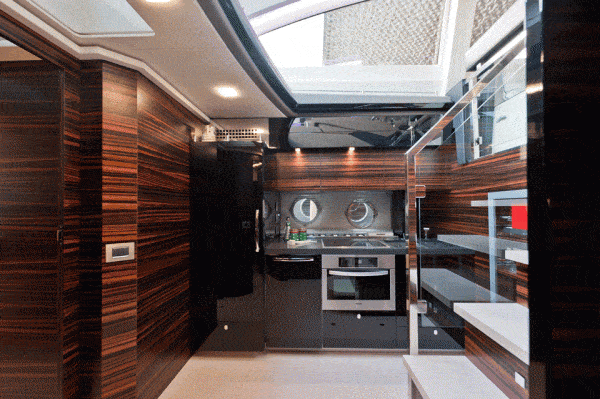
The entire midsection of the yacht is devoted to the master suite, with a centerline queen berth, built-in bureaus on both sides and six large windows. The en suite head features an oversize shower with both an overhead rain shower and a multinozzle tower.
Opposite the galley is a two-berth guest cabin with direct access to the day-head, and, with exceptional headroom, the area is brightened by overhead skylights and a large port.
A larger guest cabin is down a private corridor in the bow. On each side of the queen-size berth are stowage and, as in the other cabins, large rectangular windows that provide ample light and view.
The flybridge was clearly designed by sun-loving hedonists, and, once again, the skipper gets a luxurious chair behind a multiscreen fiberglass console. From the helm to the forward raked Venturi windshields is about a hectare of sun pad, surrounded by oversize stainless-steel rails.
Opposite the helm is a settee curving around a teak dining table, and aft is a wet bar/outdoor galley with grill and fridge. The electronics arch provides minimal shade, but a pair of cleverly designed Bimini tops unfurl from both the forward and after sides of the arch to fully protect the bridge from the midday sun.
The bridge deck extends aft and, probably for European owners, is covered with more sun pads. In this case, the owner’s daughter selected two magnificently sumptuous chaises that barely fill the area, creating yet another place to enjoy the sunset.
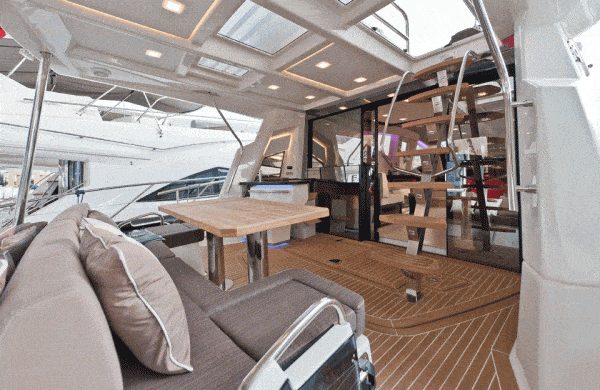
There is another cabin, this one for a single crew, but it is so tiny it hardly qualifies as a cabin. Accessed through a watertight transom door, it’s sized for European crew attitudes and I wouldn’t put my mother-in-law there. (Wait, let me think about that. … )
The engine room, though packed to the gills with two MAN V-12 diesels putting out 1,400 hp each, still has a surprising amount of space between the engines (and full headroom) to reach the essential maintenance and service points.
Under way, the Cranchi 66 is nothing if not fun. With somewhere around 5,000 pounds of torque from each of those big German juggernaut diesels, she comes up onto a plane yesterday, and we topped out at 34 knots, which is pretty quick for moving 42 tons of suede and teak and glass through a viscous medium like seawater. At top speed you are, of course, consuming fuel at a rate that will earn you Christmas and birthday cards from your fuel dock.
But back off a bit, and the 66 settles into a pleasant gallop, eating up the miles at about 24 knots at just 1800 rpm. If you want to really stretch your legs, 10 knots is not far from a mile a gallon.
With 2,800 horses lurking in the engine room, I would have expected the 66 to be, ahem, a bit high on the noise-o-meter. Shows what I know. As it turned out, we were in the mid-70-decibel range until we put the hammers all the way down, which is certainly a tribute to the effort put into insulating anything that creates noise. I’m told Cranchi puts a layer of cork under the sole throughout the yacht, and when I was in the engine room, I noticed the extensive waffle-foam insulation. The result was that, at cruising speed, the loudest noises were the bow wave and a coffee cup rattling in the galley sink. Point made.
All told, I found the Cranchi Sixty 6 Fly to be altogether charming, a blend of European styling with great attention to detail. The equipment list is remarkable, and the yacht is built to high standards.
If Giovanni Cranchi were still around, he would certainly be orgogliosi: proud.
_ View a complete photo gallery._
Test Conditions: Speeds were measured by GPS off Boca Raton, Florida, with flat seas and light winds, with a full load of fuel, a ½ load of water and four people aboard. Fuel consumption was calculated by the electronic engine-monitoring system. Sound levels were measured at the helm.
RPM Knots GPH dB(A)
600 7.3 4 62
900 9.8 12 64
1200 11.1 32 68
1500 16.4 56 72
1800 23.8 88 74
2100 29.4 110 74
2350 34.1 140 78
LOA: 68’4″
BEAM: 16’8″
DISPL.: 84,450 lb.
FUEL: 951 gal.
WATER: 223 gal.
ENGINE OPTIONS: None
ENGINES TESTED: 2 x 1,400 hp MAN V-12 D2862-LE463 diesels
BASE PRICE: $2,052,000
Yacht Works, 877-391-2941; www.yachtworksfl.com






